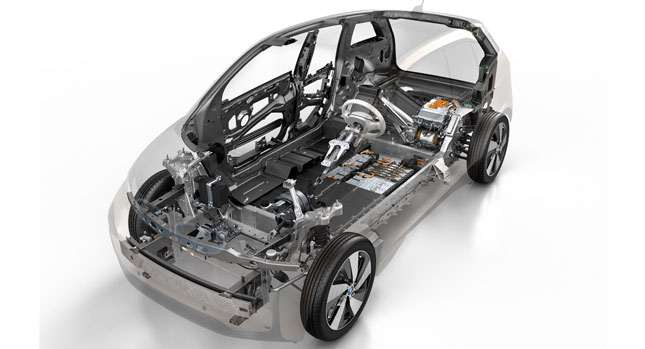True, there’s not much you can tell from these “ghost” images of the i3 that were released by BMW (though, we have a very good idea of what the production car will look like through the spy shots and patent office renders), but there’s nothing cryptic about the specifications that were also announced today.
BMW’s first venture into mass produced electric cars is a model built from the ground up under its eDrive program and it will be fully revealed on July 29 in New York.
The i3 is built around a so-called LifeDrive structure with a predominantly aluminum chassis and a carbon-fiber-reinforced plastic (CFRP) passenger cell. BMW has strived to cut weight just about everywhere – for example, the forged aluminum wheels tip the scale at a very low 15 lbs (7kg) a piece, and as a result, the i3 has a curb weight of only 1,195 kg (2,630 lbs). BMW says the sub-compact hatch also has near perfect 50:50 weight distribution.
For its motivation, the i3 uses a newly developed electric motor that is placed very close to the driven rear axle and which generates a maximum output of 168hp (170PS or 125kW) and constant torque of 184 lb-ft (250 Nm).
The motor, which weighs just 110 lbs (50 kg), sends power to the rear wheels via a single-speed transmission, with BMW quoting a 0 to 35 mph (0 – 60 km/h) acceleration time of about 3.5 seconds and a 0 to 60 mph (0-100 km/h) sprint in approximately seven seconds, which puts it on par with small GTI’s like the Ford Fiesta ST. Top speed is limited to 93 mph (150 km/h).
Feeding the electric motor is a centrally positioned lithium-ion battery developed and manufactured independently by the BMW Group. It enables the i3 to achieve a range between 80 and 100 miles (130 to 160 km) in everyday driving that can be increased by up to approximately 12 percent in ECO PRO mode and by the same amount again in ECO PRO+ mode.
If a greater driving range is necessary, buyers can order the car with the optional -extender engine, which BMW says, “maintains the charge of the lithium-ion battery at a constant level while on the move as soon as it dips below a specified value”. The engine is a BMW motorcycle-derived 650cc two-cylinder gasoline unit developing 34 hp (34PS / 25kW) mounted adjacent to the electric motor above the rear axle. According to the Bavarian firm, it “increases the car’s maximum range in day-to-day driving to around 160 to 180 miles (250 to 300 km)”.
BMW adds that specifying the range extender “has no effect on luggage capacity” as the 2.4-gallon (nine liter) fuel tank is located in the front section of the car.
And just to give owners a piece of mind, BMW says that if by any chance the i3 “fails to meet mobility requirements in a specific situation”, its newly created 360° ELECTRIC owner package will provides drivers with “flexible mobility solutions including alternative vehicles from BMW”, or in plain English, it will offer loaner vehicles.
BMW highlights the fact that the i3 is the “world’s first fully networked electrically powered car” claiming that “no other model boasts such far-reaching exchange of information between the vehicle, its driver and the outside world”. All i3s will come with an embedded SIM card that unlocks BMW ConnectedDrive services, such as navigation specially developed to enhance electric mobility, an i Remote app to share information with their car at any time using their smartphone and lots more.
PHOTO GALLERY







